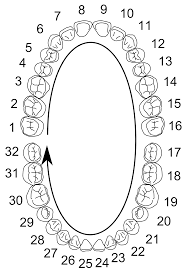
Visiting the dentist can often be stressful or disorienting for patients, but possibly the most disorienting part of every visit is all the numbers dentists, hygienists, and assistants say to each other throughout dental checkups. This short hand is used by dentists to refer to each of the teeth quickly. At McCarl Dental Group, we use the Universal numbering system which is the American Dental Association supported method.
The Universal, Palmer, & FDI Tooth Numbering Systems
There are three common tooth numbering methods, and each has their own unique advantages.
- Universal method – starting at the rear right upper molar and preceding to the rear left upper molar, teeth are numbered 1 to 16. Then, the bottom teeth are numbered from left to right 17 to 32. This numbering system allows for all 32 teeth, including wisdom teeth, to be present. If any of teeth are removed or missing, the number that corresponds to that tooth is skipped.
- Palmer method – this method counts teeth in each quadrant from 1 to 8 starting at the front teeth known as the incisors as number 1 and the very back molar is 8.
- FDI (or International) – this method, adopted by the Federation Dentaire Internationale is used outside of the United States. It uses numbers 11 to 18 to count the top right side of the smile, 21 to 28 to count the top left, 31 to 38 to count the bottom left, and 41 to 48 to count the booth right teeth.
We use the Universal method because it is supported by the American Dental Association (ADA) and taught in every dental school in the country. The Universal numbering system is used by most dentists in the US. By using this common method, we are able to easily discuss treatment with specialists and insurance companies. Most orthodontists are taught the Palmer system, but in correspondence, orthodontists include the Universal method tooth numbers to ensure clarity.
Top Areas for Tooth Decay
In patients of all ages, the molars (back teeth) are the most likely to decay due to the wide surfaces and deep pits and grooves. The front teeth tend to be given more care during daily brushing and flossing especially by children putting molars at greater risk for tooth decay. As we age, adults are more likely to experience decay where their teeth are close together or overlap which is one reason orthodontic treatment is beneficial. With improved oral hygiene, older patients may be able to keep their natural teeth for life. Age-related dental wear and dry mouth caused by medications may lead to higher risk for tooth decay in aging patients.
How to Prevent Decay at Any Age
- At-home hygiene – Daily brushing and flossing is essential to keeping smiles whole and health
- Professional dental cleanings – our dentists and hygienists carefully remove bacteria, plaque, and tartar buildup from even the hardest to reach surfaces of teeth
- Dental sealants – typically recommended for children, dental sealants are thin coats of plastic on the chewing surfaces of back teeth that seal out bacteria from deep pits and fissures
Find Out More about Decay from Your Dentist in Millersville
Whether it has been six months or six years since your last dental visit, don’t wait one more day. Contact the McCarl Dental Group team to schedule your checkup and cleaning with our team, or find out more about tooth decay prevention and treatment.
